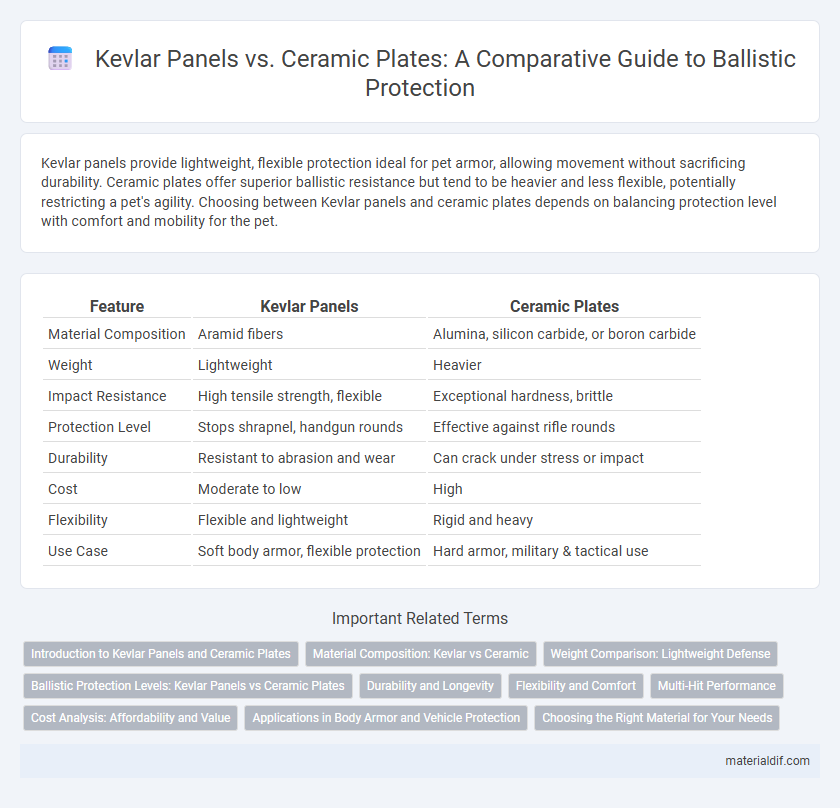Kevlar panels provide lightweight, flexible protection ideal for pet armor, allowing movement without sacrificing durability. Ceramic plates offer superior ballistic resistance but tend to be heavier and less flexible, potentially restricting a pet's agility. Choosing between Kevlar panels and ceramic plates depends on balancing protection level with comfort and mobility for the pet.
Table of Comparison
| Feature | Kevlar Panels | Ceramic Plates |
|---|---|---|
| Material Composition | Aramid fibers | Alumina, silicon carbide, or boron carbide |
| Weight | Lightweight | Heavier |
| Impact Resistance | High tensile strength, flexible | Exceptional hardness, brittle |
| Protection Level | Stops shrapnel, handgun rounds | Effective against rifle rounds |
| Durability | Resistant to abrasion and wear | Can crack under stress or impact |
| Cost | Moderate to low | High |
| Flexibility | Flexible and lightweight | Rigid and heavy |
| Use Case | Soft body armor, flexible protection | Hard armor, military & tactical use |
Introduction to Kevlar Panels and Ceramic Plates
Kevlar panels consist of aramid fibers known for their high tensile strength and lightweight properties, often used in ballistic protection and impact-resistant gear. Ceramic plates are composed of hardened ceramic materials such as alumina or silicon carbide, providing superior ballistic resistance by shattering incoming projectiles. Kevlar panels offer flexibility and multi-hit capability, while ceramic plates excel in stopping high-velocity rounds with increased durability under extreme impact conditions.
Material Composition: Kevlar vs Ceramic
Kevlar panels are composed of strong synthetic fibers with a high tensile strength-to-weight ratio, providing flexibility and impact resistance due to their aramid polymer structure. Ceramic plates consist of hard materials like alumina, silicon carbide, or boron carbide, offering superior hardness and the ability to shatter incoming projectiles upon impact. The material composition difference results in Kevlar panels being lightweight and flexible, while ceramic plates provide enhanced ballistic protection through their rigid, brittle nature.
Weight Comparison: Lightweight Defense
Kevlar panels offer significantly lighter weight compared to ceramic plates, making them ideal for applications that require mobility and prolonged wear. While ceramic plates provide superior ballistic protection against high-velocity threats, Kevlar's fiber-reinforced composite structure delivers effective defense with reduced bulk. This weight advantage of Kevlar panels enhances comfort and agility for military and law enforcement personnel without substantially compromising protective performance.
Ballistic Protection Levels: Kevlar Panels vs Ceramic Plates
Kevlar panels offer flexible ballistic protection primarily effective against handgun rounds, classified typically from Level II to Level IIIA under the NIJ standards. Ceramic plates provide superior resistance to high-velocity rifle rounds, meeting Level III to Level IV ballistic protection requiring the disruption and absorption of armor-piercing projectiles. The choice between Kevlar panels and ceramic plates depends heavily on threat level, weight constraints, and mission requirements, with ceramic plates delivering enhanced protection against armor-piercing rounds at the cost of increased weight and decreased mobility.
Durability and Longevity
Kevlar panels exhibit exceptional durability due to their high tensile strength and flexibility, which allows them to absorb and disperse impact energy effectively without cracking. Compared to ceramic plates, Kevlar maintains its protective qualities over a longer lifespan, as ceramics are prone to shattering upon heavy impact and may require frequent replacement. The longevity of Kevlar panels makes them ideal for sustained use in ballistic armor, offering reliable performance under repeated stress conditions.
Flexibility and Comfort
Kevlar panels offer superior flexibility compared to ceramic plates, allowing for greater range of motion and enhanced comfort during prolonged wear. Kevlar's lightweight and fabric-based structure reduces bulk and improves breathability, making it ideal for applications requiring agility and extended use. Ceramic plates, while providing higher ballistic protection, tend to be rigid and heavier, which can limit mobility and increase wearer fatigue.
Multi-Hit Performance
Kevlar panels provide superior multi-hit performance compared to ceramic plates, maintaining structural integrity and flexibility after multiple impacts. Kevlar fibers absorb and disperse energy effectively, reducing trauma to the wearer over successive hits. Ceramic plates tend to fracture upon impact, limiting their multi-hit durability and requiring replacement after a single strike.
Cost Analysis: Affordability and Value
Kevlar panels typically offer greater affordability compared to ceramic plates, making them a cost-effective choice for protective gear without sacrificing flexibility and weight reduction. Ceramic plates, while more expensive, provide superior ballistic resistance and are preferred for high-threat environments, offering enhanced durability and multi-hit capability. Evaluating the initial cost against long-term value, Kevlar panels deliver substantial savings for budget-conscious users prioritizing lightweight protection, whereas ceramic plates justify their higher price through advanced defense and longevity.
Applications in Body Armor and Vehicle Protection
Kevlar panels offer lightweight flexibility and superior multi-hit resistance, making them ideal for body armor used by law enforcement and military personnel requiring agility and prolonged wear. Ceramic plates provide enhanced ballistic protection against high-velocity rifle rounds, making them essential for vehicle armor and tactical vests where maximum penetration resistance is critical. Combining Kevlar panels with ceramic plates creates hybrid armor systems that balance weight, durability, and multi-threat defense across personal and vehicular protection platforms.
Choosing the Right Material for Your Needs
Kevlar panels provide lightweight flexibility and superior impact resistance, making them ideal for applications requiring mobility and comfort, such as law enforcement or sports protection. Ceramic plates offer enhanced ballistic protection against high-velocity projectiles and are preferred in military and tactical scenarios demanding maximum defense. Selecting between Kevlar panels and ceramic plates depends on balancing factors like weight, protection level, durability, and intended use environment.
Kevlar panels vs Ceramic plates Infographic

 materialdif.com
materialdif.com